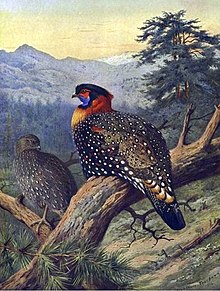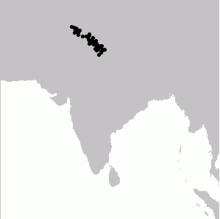Western tragopan
| Western tragopan | |
|---|---|
 |
|
| Scientific classification | |
| Kingdom: | Animalia |
| Phylum: | Chordata |
| Class: | Aves |
| Order: | Galliformes |
| Family: | Phasianidae |
| Subfamily: | Phasianinae |
| Genus: | Tragopan |
| Species: | T. melanocephalus |
| Binomial name | |
|
Tragopan melanocephalus Gray, 1829 |
|
 |
|
The western tragopan or western horned tragopan (Tragopan melanocephalus) is a medium-sized brightly plumed pheasant found along the Himalayas from north-eastern districts of Khyber Pakhtunkhwa province in northern Pakistan in the west to Uttarakhand within India to the east. The species is highly endangered and globally threatened.
The male is very dark, grey and black with numerous white spots, each spot bordered with black and deep crimson patches on the sides and back of the neck. The throat is bare with blue skin while the bare facial skin is red. They have a small black occipital crest. Females have pale brownish-grey upper parts finely vermiculated and spotted with black, and most of the feathers have black patches and central white streaks. Immature males resemble females, but are larger with longer legs and a variable amount of black on the head and red on neck.
Males weigh 1.8–2.2 kg (4.0–4.9 lb) and females weigh 1.25–1.4 kg (2.8–3.1 lb). The males vary in length from 55–60 cm (22–24 in) while the females are 48–50 cm (19–20 in).
Five populations are known from Kohistan, Kaghan valley, Kishtwar, Chamba, Kullu and an area east of the Satluj river. They are found from an altitude of 1,750 to 3,600 m, going higher in summer. Their preferred habitat is the dense understorey of temperate, subalpine and broad-leaved forest.
It inhabits upper temperate forests between 2,400 and 3,600 m in summer, and in winter, dense coniferous and broad-leaved forests between 2,000 and 2,800 m elevations. The western tragopan is mostly arboreal but feeds on the ground. They feed mostly on leaves, shoots and seeds, but also consume insects and other invertebrates. Like most pheasants, they roost in trees singly or in pairs except during nesting.
...
Wikipedia

